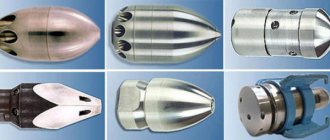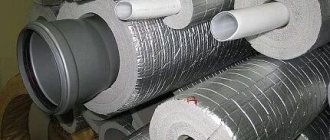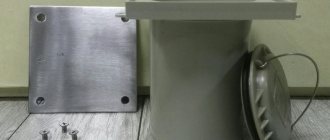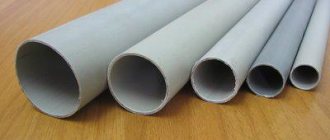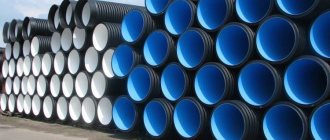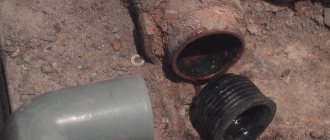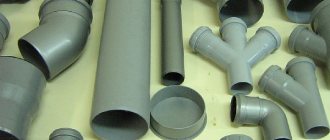- How to deal with the problem: classification of funds
- Sequence of events
- Household preventive techniques
- What will help prevent problems
- Conclusion
Prevention of sewer blockages: means, step-by-step instructions, recommendations
Any of us knows that even those pipes whose inner surface is an absolutely smooth zone become clogged. Thus, the substances that are in the water form a kind of scale in the middle of the structure, and debris and various solid particles are located on the walls. Preventing sewer blockages in order to avoid emergency cleaning is the way out of the situation. Moreover, you can carry out this kind of event yourself, without resorting to the services of professional plumbers. We will consider the specifics of the procedure below.
How to deal with the problem: classification of funds
Mechanical prevention of blockages
There is a typology of methods that can be used to clean the sewer. All technologies demonstrate effectiveness against certain blockages. So:
- a mechanical system is effective in a situation where a plug has formed within the structure, which has arisen as a result of the accumulation of various solid waste in an area that is difficult to access for cleaning. Clogging can be caused by crushed stone, branches, sand, even metal elements. Unfortunately, all this can be removed only using mechanical methods. This technology is also appropriate if it is necessary to pre-clean pipes before flushing them;
- hydrodynamic method - a method of cleaning sewers, in which a powerful water jet is supplied into the pipes under high pressure. As a result, “deposits” and remnants of silt, as well as sedimentary elements, are washed out of the system. The technology is used in places that are problematic in terms of access. The method demonstrates high efficiency rates and is also quite inexpensive. Pipe joints and seam tightness are not affected;
- thermal prevention of pipe blockages - a technology similar to the previous one. The only difference is that the water that is put into the pipes has increased temperatures;
- chemical type - involves the use of industrial and household substances for the purpose of internal cleaning of the surface of pipes. This way you can remove any remaining salt, rust, solid particles, or scale. Active components are capable of dissolving fatty deposits, washing away sludge, and also intensifying the process of removing solid diluted particles from pipes.
Using a plunger to clear a clog
Causes of sewer blockages in a private home
Over time, sewer pipes become clogged. What to do? First, you need to understand the reasons. This phenomenon has many of them, and they are almost the same as in apartment buildings. The most common problems are the following:
- Layers of dirt and grease inside the pipes. Every day, as wastewater passes through, a small amount of dirt settles on the surfaces of the canals, which accumulates over time. A blockage occurs that prevents the passage of water. Hair, wool, and fabric particles especially often get stuck in the drain after washing.
- Improper use of sewer line. When preventive and regular cleaning of pipes is not carried out, blockages occur.
- Large debris entering the system contributes to the formation of plugs.
- Inadequate sewerage system. If the angles of inclination, pipe rotations and other requirements are not met, clogging of the line is possible. The solution to the problems in this case is to rebuild the entire cleaning system. In private houses and cottages, errors associated with improper design and installation of pipelines are more common due to the terrain of the area.
- External factors: damage to pipes due to soil subsidence, freezing of the ground, penetration of plant roots into the pipeline through joints.
The first place among the main causes of blockages is the accumulation of dirt from the house. This is provoked by the discharge of waste into the sewer system, which the system does not cope well with. Let's look at their main types in order to avoid traffic jams:
- Paper is the fastest way to create a clog. When released into the aquatic environment, it increases significantly in volume and gets stuck in the pipes.
- Along with kitchen drains, grease enters the system. Other dirt sticks well to this type of deposit, and microorganisms and bacteria begin to multiply on it. The inside of the pipes becomes sticky and slimy, and a foul odor appears.
- Fabric particles fall along with the drainage of dirty water after washing floors and windows. They are formed due to the abrasion of rags. Small fibers stick to pipes and allow dirt to accumulate.
- Hair and fur most often remain on the grates, but sometimes they end up in the sewer system and, along with other waste products, get stuck in the main lines, creating problems for homeowners.
Construction debris that gets into the pipes during repair work causes great damage to the system. Various mixtures used during repair and finishing work cannot be poured into the sewer system, because the lines are immediately blocked. Sometimes, even after the first ingress of residual substances, a blockage occurs, which can only be eliminated by dismantling the pipeline.
Sequence of events
If the sewer system is clogged in your home, then first of all you should identify what type of pollution is present. In fact, determine what kind of foreign body got into the pipe and caused the problem.
To start, you can use a plunger. This is a simple technical device that can be purchased at a regular hardware store. However, its use is sometimes very useful.
So, place the device in the sink or bathtub so that its rubber element is securely attached to the drain, and water is located on top. Don't forget to close the overflow hole first - it is often located either on the side or even at the top of the bathtub itself.
Move the instrument rhythmically once or twice, alternately raising and lowering it.
There is a high probability that after such an event the problem is successfully leveled - a tool such as a plunger successfully creates a vacuum and also leads to a pressure drop, as a result of which even solid debris moves through the pipe and comes out of it.
Chemical method
In stores you can see household chemicals that help prevent blockages. They contain concentrated alkalis and acids that are highly reactive. Chemical pipe cleaning is more suitable for biological contaminants: hair, grease residues, fish scales.
This technique is not recommended to be used frequently. After all, aggressive compounds can damage the inner surface of the pipe. "Chemistry" is available in the form of liquids, gels and granules. The effectiveness of the method is high.
You might be interested in this:
- Do-it-yourself sewer pump at home
- Capacity of PVC sewer pipes
- DIY installation and dismantling of sewer pipes
Household preventive techniques
Flexible metal cable when clogged
If the tool does not cope with the task assigned to it, so that the sewer does not become clogged, use the method of mechanically cleaning it. An ordinary flexible metal cable will help with this.
Wind up the structure, and gradually insert one end into the pipe, slowly pushing it deeper into the structure. When there is a blockage in the path of the device, make movements more intense.
Over time, the garbage will gradually crumble due to the action of the cable, after which it will disintegrate into individual mechanical elements, which themselves will enter the general sewer system with the flow of water.
To clean the toilet, you can use a piece of simple rubber hose. So, arm yourself with protective gloves and gradually carefully move the structure into the plumbing drain. The hose will cope with the blockage, small segments of which, after exposure, will independently leave the drain and enter the sewer system.
Chemical products also show good results. They should be used when all mechanical methods have proven ineffective.
The most popular liquid is “Mole” - however, it should be used extremely carefully, while observing all safety measures, such a mixture is quite aggressive.
Do not forget that aggressive chemical compounds negatively affect the condition of the inner surface of metal and plastic pipes and, over time, render them functionally unusable. Use such products in very rare cases.
A non-trivial method of cleaning the system is to insert a hose into the clogged structures and release strong water pressure through it. This activity can be carried out by connecting the device to a standard tap.
Sometimes in stores you can find special hydrodynamic pumps designed for domestic use. They are equipped with all kinds of attachments that are used for one or another type of functional blockage of the system.
How and with what to determine the location of the blockage
To choose the right way to remove the blockage, you will need to determine its location. Most often, the siphon, bends and turns of the pipe, and the junction with the riser of an apartment building become clogged.
Plumbers locate the plug using a special metal cable, sometimes with video surveillance. To determine the location of the blockage yourself, you need to turn on the water or flush it in the case of a toilet, and observe exactly how it drains.
If the liquid leaves slowly, most likely, the blockage occurred at a distance of a meter and a half from the drain point. If the drainage of liquid stops at a certain level, the area between the siphon and the first bend of the pipe is clogged. If the liquid does not leave at all, then the siphon is most likely clogged.
In the case of a plastic pipeline, you can illuminate it with a powerful flashlight.
There will be a darker area where the clog occurs. Pay attention to the corrugated hose; debris often accumulates in it.
If you find that water is standing in all the existing plumbing and even comes when the tap is closed, urgently call a specialist, since most likely the central riser is clogged, which threatens a flood.
What will help prevent problems
Preventing sewer blockages is the best method to eliminate all potential troubles associated with pipes that become clogged during operation.
A set of measures should be carried out periodically to maintain the internal cleanliness of the system.
Tips and tricks:
Grids for sewer drain holes
- Any plumbing equipment requires periodic preventive cleaning - so, from time to time, do not be lazy to disassemble the pipes and wash them;
- every few days, open the hot water tap and flush the system - this will protect the pipes from excessive accumulation of fatty deposits;
- meshes designed for sinks, made of plastic, reliably protect structures from the ingress of unnecessary debris. They are cheap and highly effective.
- Under no circumstances should you throw anything into the system yourself - waste accumulates and forms a dense, impenetrable plug.
Thus, following simple recommendations helps to avoid negative consequences and carry out a set of measures aimed at cleaning sewer fixtures.
Sewer pipe prevention
Preventative work to prevent blockages in the sewer system will help save time, and compliance with the rules of operation of the sewer system will become a habit.
Cleaning of sewer pipes must be done once a month. To prevent blockages from forming, you should pay attention to the main signs:
- slow drainage of water from the sink;
- the same slow flow of water after it is flushed from the toilet cistern;
- It takes more than 4-5 minutes for the water to drain from the bathroom.
If one of these signs of pipe clogging appears, preventive cleaning should be carried out. You can do this yourself, or you can seek the services of specialists who carry out preventive cleaning and, if necessary, help pump out the sewer.
